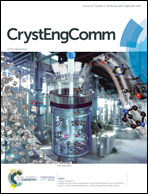Bubble-template synthesis of WO3·0.5H2O hollow spheres as a high-activity catalyst for catalytic oxidation of benzyl alcohol to benzaldehyde†
Abstract
Although significant progress has been made in WO3 hollow spheres, it is still a challenge to synthesize WO3·0.5H2O hollow spheres. Herein, a strategy for the preparation of well-shaped WO3·0.5H2O hollow spheres was developed by a facile bubble-template method using urea as a foaming agent in the solvothermal process with EtOH–H2O mixture solvent. In this process, the growth of WO3·0.5H2O nanoparticles is limited by N-containing organic compounds, thus these nanoparticles tend to agglomerate along the surface of bubbles (CO2 and NH3) to fabricate hollow spheres with pores formed in the wall, and after low temperature calcination, pure WO3·0.5H2O hollow spheres are obtained. The obtained WO3·0.5H2O hollow spheres exhibit enhanced activity in catalytic oxidation of benzyl alcohol to benzaldehyde: the conversions of benzyl alcohol, 4-methyl, 3-methyl, 2-methyl, 4-bromo and 4-nitro benzyl alcohol are 99.2%, 95.0%, 97.1%, 86.7%, 98.0%, 90.6%, respectively, and the selectivities to corresponding benzaldehydes are all greater than 98%. The high activity of WO3·0.5H2O hollow spheres could be attributed to surface –OH groups and the hollow and porous structure.



 Please wait while we load your content...
Please wait while we load your content...